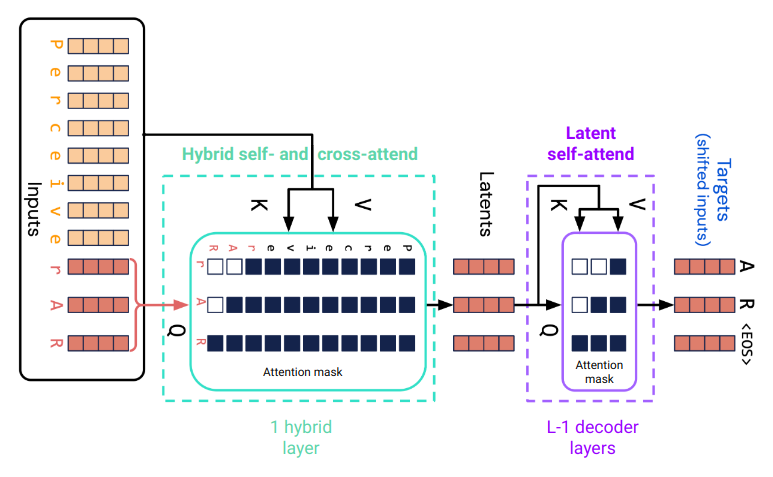Perceiver AR symbolic audio model
This model is a Perceiver AR symbolic audio model (134M parameters) pretrained on the GiantMIDI-Piano dataset for 27 epochs (157M tokens). It uses rotary embedding for relative position encoding. It is a training example of the perceiver-io library.
Model description
Perceiver AR is a simple extension of a plain decoder-only transformer such as GPT-2, for example. A core building block of both is the decoder layer consisting of a self-attention layer followed by a position-wise MLP. Self-attention uses a causal attention mask.
Perceiver AR additionally cross-attends to a longer prefix of the input sequence in its first attention layer. This layer is a hybrid self- and cross-attention layer. Self-attention is over the last n positions of the input sequence, with a causal attention mask, cross-attention is from the last n positions to the first m positions. The length of the input sequence is m + n. This allows a Perceiver AR to process a much larger context than decoder-only transformers which are based on self-attention only.

Fig. 1. Attention in Perceiver AR with m=8 prefix tokens and n=3 latent tokens.
The output of the hybrid attention layer are n latent arrays corresponding to the last n tokens of the input sequence. These are further processed by a stack of L-1 decoder layers where the total number of attention layers is L. A final layer (not shown in Fig. 1) predicts the target token for each latent position. The weights of the final layer are shared with the input embedding layer. Except for the initial cross-attention to the prefix sequence, a Perceiver AR is architecturally identical to a decoder-only transformer.
Model training
The model was trained with the task of symbolic audio modeling on the GiantMIDI-Piano dataset for 27 epochs (157M tokens). This dataset consists of MIDI files, tokenized using the approach from the Perceiver AR paper, which is described in detail in Section A.2 of Huang et al (2019). All hyperparameters are summarized in the training script. The context length was set to 6144 tokens with 2048 latent positions, resulting in a maximal prefix length of 4096. The actual prefix length per example was randomly chosen between 0 and 4096. Training was done with PyTorch Lightning and the resulting checkpoint was converted to this 🤗 model with a library-specific conversion utility.
Intended use and limitations
This model can be used for audio generation with a user-defined initial number of latent tokens. It mainly exists for demonstration purposes on how to train Perceiver AR models with the perceiver-io library. To improve on the quality of the generated audio samples a much larger dataset than GiantMIDI-Piano is required for training.
Usage examples
To use this model you first need to install
the perceiver-io library with extension audio.
pip install perceiver-io[audio]
Then the model can be used with PyTorch. Either use the model directly to generate MIDI files:
import torch
from perceiver.model.audio.symbolic import PerceiverSymbolicAudioModel
from perceiver.data.audio.midi_processor import decode_midi, encode_midi
from pretty_midi import PrettyMIDI
repo_id = "krasserm/perceiver-ar-sam-giant-midi"
model = PerceiverSymbolicAudioModel.from_pretrained(repo_id)
prompt_midi = PrettyMIDI("prompt.mid")
prompt = torch.tensor(encode_midi(prompt_midi)).unsqueeze(0)
output = model.generate(prompt, max_new_tokens=64, num_latents=1, do_sample=True, top_p=0.95, temperature=1.0)
output_midi = decode_midi(output[0].cpu().numpy())
type(output_midi)
pretty_midi.pretty_midi.PrettyMIDI
use a symbolic-audio-generation pipeline to generate a MIDI output:
from transformers import pipeline
from pretty_midi import PrettyMIDI
from perceiver.model.audio import symbolic # auto-class registration
repo_id = "krasserm/perceiver-ar-sam-giant-midi"
prompt = PrettyMIDI("prompt.mid")
audio_generator = pipeline("symbolic-audio-generation", model=repo_id)
output = audio_generator(prompt, max_new_tokens=64, num_latents=1, do_sample=True, top_p=0.95, temperature=1.0)
type(output["generated_audio_midi"])
pretty_midi.pretty_midi.PrettyMIDI
or generate WAV output by rendering the MIDI symbols using fluidsynth (Note: fluidsynth must be installed in order for the following example to work):
from transformers import pipeline
from pretty_midi import PrettyMIDI
from perceiver.model.audio import symbolic # auto-class registration
repo_id = "krasserm/perceiver-ar-sam-giant-midi"
prompt = PrettyMIDI("prompt.mid")
audio_generator = pipeline("symbolic-audio-generation", model=repo_id)
output = audio_generator(prompt, max_new_tokens=64, num_latents=1, do_sample=True, top_p=0.95, temperature=1.0, render=True)
with open("generated_audio.wav", "wb") as f:
f.write(output["generated_audio_wav"])
Audio samples
The following (hand-picked) audio samples were generated using various prompts from the validation subset of the GiantMIDI-Piano dataset. The input prompts are not included in the audio output.
| Audio sample | Top-K | Top-p | Temperature | Prefix length | Latents |
|---|---|---|---|---|---|
| - | 0.95 | 0.95 | 4096 | 1 | |
| - | 0.95 | 1.0 | 4096 | 64 | |
| - | 0.95 | 1.0 | 1024 | 1 | |
| 15 | - | 1.0 | 4096 | 16 | |
| - | 0.95 | 1.0 | 4096 | 1 |
Checkpoint conversion
The krasserm/perceiver-ar-sam-giant-midi model has been created from a training checkpoint with:
from perceiver.model.audio.symbolic import convert_checkpoint
convert_checkpoint(
save_dir="krasserm/perceiver-ar-sam-giant-midi",
ckpt_url="https://martin-krasser.com/perceiver/logs-0.8.0/sam/version_1/checkpoints/epoch=027-val_loss=1.944.ckpt",
push_to_hub=True,
)
Citation
@inproceedings{hawthorne2022general,
title={General-purpose, long-context autoregressive modeling with perceiver ar},
author={Hawthorne, Curtis and Jaegle, Andrew and Cangea, C{\u{a}}t{\u{a}}lina and Borgeaud, Sebastian and Nash, Charlie and Malinowski, Mateusz and Dieleman, Sander and Vinyals, Oriol and Botvinick, Matthew and Simon, Ian and others},
booktitle={International Conference on Machine Learning},
pages={8535--8558},
year={2022},
organization={PMLR}
}
- Downloads last month
- 9